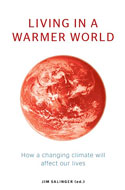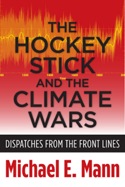 Stephen Schneider, one of the world’s most highly regarded and influential climate scientists, died today aged 65. The climate science community has responded with some heartfelt tributes. Real Climate carries a eulogyfrom Ben Santer which expresses the feelings of Schneider’s colleagues and the recognition he deserves for his understanding, his courage and his concern for our life on this planet. NZ’s Jim Salinger, at present in Brazil, forwarded his personal response to me earlier today:
Stephen Schneider, one of the world’s most highly regarded and influential climate scientists, died today aged 65. The climate science community has responded with some heartfelt tributes. Real Climate carries a eulogyfrom Ben Santer which expresses the feelings of Schneider’s colleagues and the recognition he deserves for his understanding, his courage and his concern for our life on this planet. NZ’s Jim Salinger, at present in Brazil, forwarded his personal response to me earlier today:
My friendship with a great human being Stephen Schneider goes back to 1979. Others have written very eloquently and with feeling about him. As I write this I am numb at this loss of this friend of science, people and life on this planet. Steve was an extremely caring person to his friends as well to all life on earth. We both shared the ‘same page’ about the planet way back in 1979 when we first met. Since then, and as his friend Paul Ehrlich said even then he needed younger folk to follow him to keep reminding politicians and people about our responsibilities to people and the planet. Steve certainly did this and more. As a friend he was always there to help you, as a scientist he had a huge intellect but took pains to explain details on climate science in appropriate language, by using analogies suited to the audience and people he was addressing. He will be sorely missed by all of us, and planet earth has been a better place for his life on this world. My soulmate Carolyn and I had the pleasure of spending time with him only last month, on one evening singing Bob Dylan and other songs as he strummed his 12-string guitar. It was a privilege to know and share time with such a great man. And as Steve and I say in our culture at this time we wish Terry, Becca, Adam and family ‘Long Life’.
Here’s Schneider in 1979, when Jim first met him. 30 years on, Schneider’s careful presentation of the facts looks remarkably apropos [h/t Michael Tobis]:
[youtube]pB2ugPM0cRM[/youtube]
Bryan Walker adds: It’s worth recalling some of the things he wrote in Science as a Contact Sport, which I recently reviewed for Hot Topic. Tim Flannery provided the introduction, in which he recalled first meeting Schneider at a conference in Japan a decade ago.
“His words on the danger of a changing climate to biodiversity hit like a thunderbolt, and from then on I was convinced of the truly dire nature of the threat that climate change is to our planet. His presentation was clear, packed with information, and funny. It was the last thing I expected from a great man addressing a serious topic, but I soon learned that one of Steve’s greatest assets is to bring humour to overly serious debates.”
On modelling, of which he was an early exponent:
“If you don’t model, you don’t know anything about the future.”
On the IPCC, in which he was a leading figure:
“IPCC represented the culture of community. We can’t asses complex systems science individually, nor can we solve the global policy problem without coalitions and communities with a common concern.”
In response to Senator James Inhofe when around 2007 he read a statement into the Congressional Record saying Schneider was the father of the greatest environmental hoax:
“I recall sending some email to his office thanking the senator for the honour, but respectfully declining as I have a thousand equally deserving colleagues.”
On the impact of climate change on indigenous peoples:
“No community should be forced from their home or their culture – whether a tropical reef island or a once frozen tundra.”
In response to a NZ reporter on the sacking of Jim Salinger from NIWA:
“Managers are a dime a dozen, world-class scientists very rare. Maybe the wrong guy at NIWA got sacked.”
On the attempts his students sometimes make to comfort him:
“You can at least say ‘I told you so’!” “Nah,” I reply, “an ‘I told you so’ is really an ‘I failed you so’ – we just didn’t get it done.”
He worried over how many decent people are still taken in by the political chicanery of ideologists and special interests:
“What keeps me awake at night is a disquieting thought; ‘Can democracy survive complexity?’”
His concluding paragraph:
“But most important, for me, as grandparent, parent, and teacher, is to hum in your head often the lines of the Crosby, Stills, and Nash song from decades ago. The advice is still the most important thing any of us can do as individuals: ‘Teach your children well.’”
Schneider continued actively engaged right up to the time of his death. It’s only a few weeks since we reported publication of the article he co-authored which investigated the relative credibility of climate researchers and contrarians. Climate Science Watch interviewed him about the article. A video clip of some of the interview, well worth watching, is included along with a full transcript.
He felt the full force of American right-wing fringe fury in recent times. He reported recently that he had received hundreds of violently abusive emails since last November, with the number picking up again following publication of the recent article. He said he had observed an immediate, noticeable rise in emails whenever climate scientists were attacked by prominent right-wing US commentators, such as Glenn Beck and Rush Limbaugh.
Earlier this year his name appeared on a “death list” on a neo-Nazi website alongside other climate scientists with apparent Jewish ancestry.
“The effect on me has been tremendous,” he said. “Some of these people are mentally imbalanced. They are invariably gun-toting rightwingers…I have now had extra alarms fitted at my home and my address is unlisted. I get scared that we’re now in a new Weimar republic where people are prepared to listen to what amounts to Hitlerian lies about climate scientists.”
Sadly climate scientists have to endure many such attacks. But Schneider didn’t shrink from representing fairly and squarely the risks of climate change and the urgency of our need to face up to them. Vilified by a few, he will be honoured by many.
[youtube]az9Az6S1nus[/youtube]
Like this:
Like Loading...
 This year really has started with a bang. An unusual concatenation of weather extremes — Britain’s stormy and wet winter – the wettest since records began, 250 years ago – the warm winter in Russia and Alaska, drought in California and Australian heatwaves — has caused many people to consider the role that climate change might have played in driving those weather events. For once, public debate has moved away from the tired old is it/isn’t it happening frame and into concern about what living in a warming world might actually mean for us all. This makes Jim Salinger’s latest book, Living In A Warmer World – How a changing climate will affect our lives (Bateman NZ, 2013) especially welcome.
This year really has started with a bang. An unusual concatenation of weather extremes — Britain’s stormy and wet winter – the wettest since records began, 250 years ago – the warm winter in Russia and Alaska, drought in California and Australian heatwaves — has caused many people to consider the role that climate change might have played in driving those weather events. For once, public debate has moved away from the tired old is it/isn’t it happening frame and into concern about what living in a warming world might actually mean for us all. This makes Jim Salinger’s latest book, Living In A Warmer World – How a changing climate will affect our lives (Bateman NZ, 2013) especially welcome.


 Stephen Schneider, one of the world’s most highly regarded and influential climate scientists, died today aged 65. The climate science community has responded with some heartfelt tributes. Real Climate carries a
Stephen Schneider, one of the world’s most highly regarded and influential climate scientists, died today aged 65. The climate science community has responded with some heartfelt tributes. Real Climate carries a